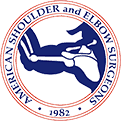Printable PDFs
Post-Shoulder Surgery
RANGE OF MOTION / STRETCHING
Flexion


Abduction


External rotation


Internal rotation

Corner stretch

STRENGTHENING
External rotation – With your elbow bent and your arm at your side, rotate your arm outward against the resistance of a TheraBand. Slowly return to the start position and repeat. Keep your elbow at your side and your shoulders square. “Squeeze” your shoulder blades together while you rotate out. If you do not have a band, you can also perform this exercise with a partner or with a wall or post pressing against the outside of the wrist.
External rotation at 0 degrees of abduction


External rotation at 90 degrees of abduction


Internal rotation – With your elbow bent and your arm at your side, rotate your arm across your body against the resistance of a TheraBand. Slowly return to the start position and repeat. Keep your elbow at your side.
Internal rotation at 0 degrees of abduction


Internal rotation at 90 degrees of abduction


LRow Exercise – Stand facing a door with the TheraBand attached to the doorknob. Start with your elbows bent and your upper arms at your side. Keep your upper arm close to your side and begin by engaging your shoulder blades first so they are centered on your back. Next, pull back until your hand is level with your body as you concentrate on pulling your shoulder blades back and down towards the center of your lower back. Concentrate on your posture so that your spine is in a straight line and your head and neck are centered over the back of your pelvis. Then slowly return to the start position. “Squeeze” your shoulder blades together as you pull. You can repeat with the elbows straight, pulling down.

Scapular Strengthening Exercises – During these exercises, focus upon pulling the shoulder blades together. Start by squeezing the shoulder blades together to get used to the muscles that contract to bring your shoulder into this position. Recreate this sensation during the exercise. Lie on your stomach with your arm hanging towards the floor. Raise your arm to your side until it is parallel to the floor. You can also perform this exercise on an exercise ball to work your core or using TheraBand. Repeat with the arms in a “T”, “Y” and “I” position. Use the weight of your arm or a 4-6 oz. can of tuna fish or tomato soup for three sets of 10-12.
I position


T position


Y position


RANGE OF MOTION / STRETCHING
Flexion


Abduction


External rotation


Internal rotation

Corner stretch

STRENGTHENING
External rotation – With your elbow bent and your arm at your side, rotate your arm outward against the resistance of a TheraBand. Slowly return to the start position and repeat. Keep your elbow at your side and your shoulders square. “Squeeze” your shoulder blades together while you rotate out. If you do not have a band, you can also perform this exercise with a partner or with a wall or post pressing against the outside of the wrist.
External rotation at 0 degrees of abduction


External rotation at 90 degrees of abduction


Internal rotation – With your elbow bent and your arm at your side, rotate your arm across your body against the resistance of a TheraBand. Slowly return to the start position and repeat. Keep your elbow at your side.
Internal rotation at 0 degrees of abduction


Internal rotation at 90 degrees of abduction


LRow Exercise – Stand facing a door with the TheraBand attached to the doorknob. Start with your elbows bent and your upper arms at your side. Keep your upper arm close to your side and begin by engaging your shoulder blades first so they are centered on your back. Next, pull back until your hand is level with your body as you concentrate on pulling your shoulder blades back and down towards the center of your lower back. Concentrate on your posture so that your spine is in a straight line and your head and neck are centered over the back of your pelvis. Then slowly return to the start position. “Squeeze” your shoulder blades together as you pull. You can repeat with the elbows straight, pulling down.

Scapular Strengthening Exercises – During these exercises, focus upon pulling the shoulder blades together. Start by squeezing the shoulder blades together to get used to the muscles that contract to bring your shoulder into this position. Recreate this sensation during the exercise. Lie on your stomach with your arm hanging towards the floor. Raise your arm to your side until it is parallel to the floor. You can also perform this exercise on an exercise ball to work your core or using TheraBand. Repeat with the arms in a “T”, “Y” and “I” position. Use the weight of your arm or a 4-6 oz. can of tuna fish or tomato soup for three sets of 10-12.
I position


T position


Y position


After a shoulder replacement, most patients have reached a peak in their improvement at one year from surgery. However, continuing with a healthy exercise program for the muscles around the shoulder and carefully selecting activities will help optimize shoulder function and reduce risk of the prosthesis loosening and shoulder irritability. Many have questions about what they can do and what they should avoid for the long term, in an effort to keep their shoulder healthy.
What activities/sports are allowed after a shoulder replacement?
a) Following shoulder replacement, your surgeon will have a rehabilitation protocol that lets you gradually regain shoulder function while protecting the replacement so that the shoulder heals appropriately, in particular the front rotator cuff called the subscapularis that has to be re-attached after replacement. This generally involves a sling for 6 weeks with supervised physical therapy to regain motion. Strengthening begins several months after replacement, a progressive return to activities 4-6 months from surgery, and improvement at a year from surgery. It is important to follow your surgeon’s protocol for the best outcome.
b) After recovering from shoulder replacement, patients may generally resume most activities and sports as tolerated, unless directed otherwise by their surgeon.
What activities and sports are best avoided?
a) Some surgeons recommend avoiding activities that place higher stress on the shoulder replacement in order to potentially reduce the risk of the replacement loosening. This would include pushups, bench press, and overhead. Many would also advise against heavy manual labor and extreme power tools such as a jackhammer.
Is there a weight limit on what I can do for the long term after a replacement?
a) Reverse: discuss limits with your surgeon, there are different opinions ranging from activity as tolerated to a 20 lb weight limit, especially with overhead lifting.
b) Anatomic: there is generally no weight limit, although some surgeons recommend avoiding activities that place higher stress on the shoulder replacement in order to potentially reduce the risk of the replacement loosening. This would include pushups, bench press, and overhead weightlifting.
Are there any activities I should absolutely avoid?
a) Discuss with your surgeon based on your type of replacement. It may be worthwhile to avoid pushups, bench press, and heavier overhead lifting, particularly following a reverse shoulder replacement.
What are some tips to keeping my shoulder healthy and pain-free?
a) When weightlifting, patients may consider lower-weight and higher-repetition exercises. Generally, exercises that involve lifting overhead, i..e Olympic style-lifts, such as squat press, overhead press, and jerk-type exercises, are harder on your shoulders and may be best to avoid after shoulder replacement, particularly reverse replacement. Make sure you have strengthened the small stabilizing muscles, such as the rotator cuff muscles and scapular stabilizers, before strengthening the larger muscles such as the deltoid, trapezius, and pectoralis. Seated row exercises with a band are important to balance the shoulder help the rotator cuff function.
b) Maintain a healthy lifestyle, including maintaining a healthy weight and avoiding problems that can arise from lack of exercise and an excess of unhealthy foods.
When to be worried:
- Let your doctor know if you develop new pain or weakness of the shoulder, as this could be a sign of problems with the replacement. This is particularly true if you have a specific injury with new onset pain or weakness, but also if pain or weakness begins more gradually.
- Also notify your doctor if you develop signs of infection (redness, swelling, warmth), or symptoms of instability of the replacement.
What is a good shoulder exercise regimen to keep my shoulder replacement functioning well?
Below is a list of exercises, that can be done 2-3 times per week, as an addition to any exercise routine, to keep you shoulder flexible, strong, and pain-free. These exercises generally require you to obtain a set of therabands, which are large rubber bands of varying resistance, or light weights. Keep the tension/weight of the band light to avoid straining the shoulder.
After a shoulder surgery (rotator cuff, biceps surgery, bone spurs) many patients have reached their maximum improvement when they are one year out from their surgery, but it is possible to continue improving up to 24 months. Many have questions about what they can do and what they should avoid for the long term, in an effort to keep their shoulder healthy.
1) What activities/sports are allowed after a rotator cuff repair?
a. Following rotator cuff repair, your surgeon will have a rehabilitation protocol that lets you gradually regain shoulder function while protecting the repair so that the rotator cuff tendon heals back to the humerus bone. This generally involves a sling for 4-6 weeks with supervised physical therapy to regain motion. Strengthening begins several months after repair, return to activities 5-6 months from surgery, and while the majority of improvement is obtained by the one-year mark, many continue to improve beyond that. It is important to follow your surgeon’s protocol for the best outcome.
b. After recovering from rotator cuff repair, patients may generally resume all activities and sports as tolerated, unless directed otherwise by their surgeon.
2) What activities and sports are best avoided?
a. After recovering from rotator cuff repair, patients can return to all activities and sports as tolerated, unless directed otherwise by their surgeon.
3) Is there a weight limit on what I can do for the long term after a rotator cuff repair?
a. No. Patients can generally return to lifting weights, however, consult with MD regarding safe weight to resume . No heavy lifting for 9 months
4) Are there any activities I should absolutely avoid?
a. Please consult with your physician and physical therapist regarding activities you should avoid. Activities such as heavy overhead lifting and rock-climbing can be difficult on the repair.
b. Activities that involve sudden quick movements, sudden jerking or hanging should be avoided for 6-7 months following surgery. Activities such as weightlifting cleans, overhead pressing, pull ups, chin ups, hanging, and throwing a ball should be delayed until full strength has returned & full healing has occurred.
5) What are some tips to keeping my shoulder healthy and pain-free?
a. When weightlifting, patients may consider lower-weight and higher-repetition exercises. Generally, exercises that involve lifting overhead, i..e Olympic style-lifts, such as squat press, overhead press, and jerk-type exercises, are harder on your shoulders than below-shoulder lifts. Make sure you focus on the small stabilizing muscles, such as the rotator cuff muscles and scapular stabilizers.
b. Restoring full motion is important to pain free full shoulder function. Continue to perform your shoulder range of motion exercises. These can be done with a stick, or golf club. Perform shoulder flexion, external & internal rotation motions.
c. Maintaining good posture is essential to pain- free shoulder function and cuff healing. Maintain anterior shoulder flexibility and strengthen the scapular muscles. Perform exercises such as the corner stretch to stretch pectoralis minor and then strengthen the scapular muscles with rowing, standing T’s & I’s.
d. Maintain a healthy lifestyle, including maintaining a healthy weight and avoiding problems that can arise from lack of exercise and an excess of unhealthy foods. Obesity is related to arthritis of the shoulder. Diabetes, which is related to obesity, can contribute to a frozen shoulder and to rotator cuff tears. Thus, maintaining a healthy weight can also prevent shoulder problems.
5) WHAT’s Good to DO for the Shoulder:
a. Staying active and using your shoulder
b. Improving your posture.
c. Doing good shoulder functional activities such as cuff strengthening exercises, golf, full body exercise
d. Maintaining a stretching program
6) When to be worried:
a. Let your doctor know if you develop new pain or weakness of the shoulder, as this could be a sign of rotator cuff problems after repair. This is particularly true if you have a specific injury with new onset pain or weakness, as this could represent a re-tear of the repair.
7) What is a good shoulder exercise regimen to keep my rotator cuff repair functioning well?
a. You should ask your Physical Therapist for a HEP (home exercise program) at your last visit, however, below is a list of the range of motion and strengthening exercises, that can be done 1-3 times per week, as an addition to any exercise routine, to keep you shoulder flexible, strong and pain-free. These exercises generally require you to obtain a set of TheraBands, which are large rubber bands of varying resistances, or light weights. We all want to be strong as possible but keep the resistance light so that you use proper form, this will make your shoulder stronger and more stable.
Post-Elbow Surgery
Wrist flexion and extension stretch:
With the elbow extended, palm facing down and the shoulder at 90 degrees of elevation, extend your wrist as far as you can. Then use your opposite hand to extend the wrist even further. You should feel a stretch in your forearm. Once completed, flex your wrist. Use the opposite hand to stretch the wrist into flexion. Again, you will feel a stretch in your forearm.
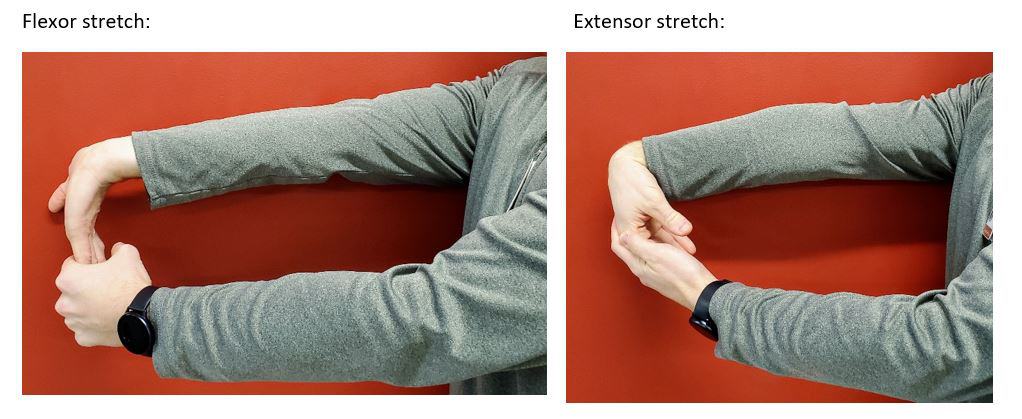
Gripping Exercises:
This can be done with a ball, a handheld gripper, or any other device that provides resistance while you attempt to make a fist. This will help strengthen the muscles of the forearm and will keep the elbow health. Be careful not to do this exercise if you are experiencing tennis elbow.
Forearm Rotation Exercises:
With a 1- or 2-pound weight held in your hand (or more if needed), elbow bent, simply turn your palm up and down, keeping the shoulder and elbow immobile. Perform this exercise with your elbow flexed to create forearm supination/pronation. This should be done in a very controlled manner to avoid any excess stress on the elbow. This can be done for 3 sets of 10.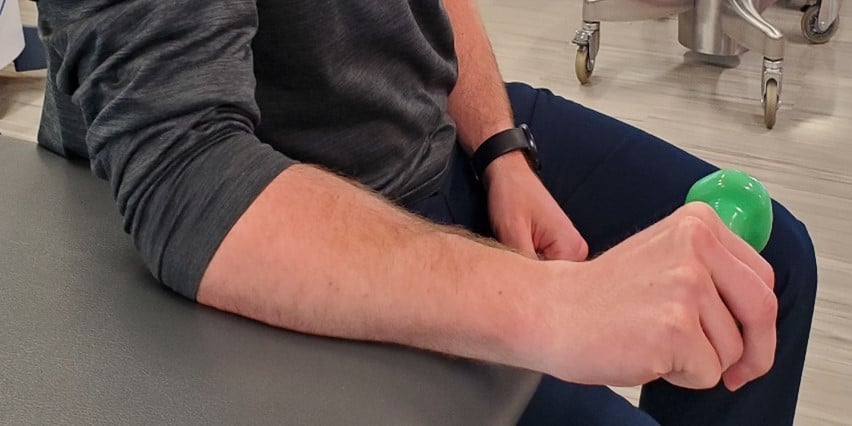
Wrist curls (flexion):
Using a small hand weight in your hand, straighten your elbow, rest your forearm on the edge of the table or arm rest, palm up. Start with your wrist extended (palm should be facing away from you now), then curl the weight up (palm facing you). Perform in a controlled manner and perform 3 sets of 10.
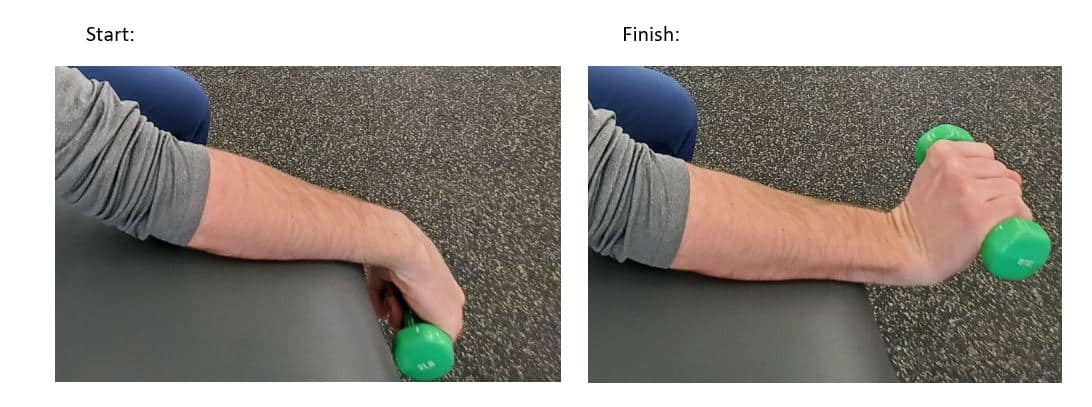
Wrist curls (extension):
Using a small hand weight in your hand, straighten your elbow, rest your forearm on the edge of the table or arm rest, palm down. Start with wrist flexed (fingers down), then curl the weight up (back of your hand should be facing you). Perform in a controlled manner and perform 3 sets of 10.
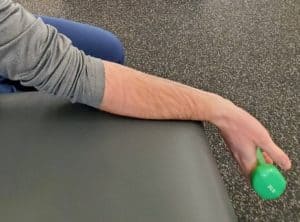
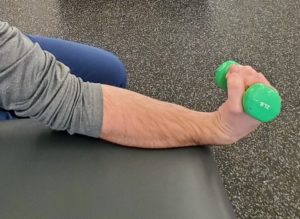
Wrist flexion and extension stretch:
With the elbow extended, palm facing down and the shoulder at 90 degrees of elevation, extend your wrist as far as you can. Then use your opposite hand to extend the wrist even further. You should feel a stretch in your forearm. Once completed, flex your wrist. Use the opposite hand to stretch the wrist into flexion. Again, you will feel a stretch in your forearm.

Gripping Exercises:
This can be done with a ball, a handheld gripper, or any other device that provides resistance while you attempt to make a fist. This will help strengthen the muscles of the forearm and will keep the elbow health. Be careful not to do this exercise if you are experiencing tennis elbow.
Forearm Rotation Exercises:
With a 1- or 2-pound weight held in your hand (or more if needed), elbow bent, simply turn your palm up and down, keeping the shoulder and elbow immobile. Perform this exercise with your elbow flexed to create forearm supination/pronation. This should be done in a very controlled manner to avoid any excess stress on the elbow. This can be done for 3 sets of 10.
Wrist curls (flexion):
Using a small hand weight in your hand, straighten your elbow, rest your forearm on the edge of the table or arm rest, palm up. Start with your wrist extended (palm should be facing away from you now), then curl the weight up (palm facing you). Perform in a controlled manner and perform 3 sets of 10.

Wrist curls (extension):
Using a small hand weight in your hand, straighten your elbow, rest your forearm on the edge of the table or arm rest, palm down. Start with wrist flexed (fingers down), then curl the weight up (back of your hand should be facing you). Perform in a controlled manner and perform 3 sets of 10.


After an elbow surgery, most patients have reached their maximum improvement when they are one year out from their surgery. Many have questions about what they can do and what they should avoid for the long term, to keep their elbow healthy.
1) What activities/sports are allowed after an elbow replacement?
- General activities of daily living such as cooking, cleaning, etc. can be performed after an elbow replacement
- Craft activities such as knitting and crocheting
- Board games, cards, etc.
2) What activities and sports are best avoided after an elbow replacement?
- Racket sports or throwing activities should be avoided after an elbow replacement
- Contact sports should be avoided after an elbow replacement
- Sports with a major risk of falling (horseback riding, climbing, etc.) should be avoided after an elbow replacement
3) Is there a weight limit on what I can do for the long term after a replacement?
- Generally you should avoid lifting objects more than 15lbs.
4) What about after Tommy John Surgery, what sports/activities are allowed?
- Once you have completely recovered from Tommy John surgery, there are no restrictions placed on your elbow. You can perform all activities of daily living and compete in all sports.
5) What activities are best avoided?
- There are no activities that need to be avoided after the person has completed rehabilitation from Tommy John surgery (which can take 12 to 15 months for a full recovery and return to full pitching/throwing activities). Activities that stress the surgery include throwing a baseball, throwing a javelin, and weightbearing activities on the elbow such as gymnastics
- Is there a weight limit? – no, there is no weight limit for lifting set on the elbow after full recovery from Tommy John surgery
6) What are some tips to keeping my elbow healthy and pain-free?
- Following elbow surgery, it is important to maintain your elbow motion as best as possible. Take a few minutes each day to completely bend and straighten your elbow to avoid any loss of motion.
- After elbow surgery your elbow may flare up on you from time to time. This is normal. When this happens, ice the elbow and take some anti-inflammatory medications if you can tolerate these and do not have any contraindication to taking them.
7) When to be worried:
- If you have had prior surgery on your elbow such as a tendon or ligament repair and feel a “pop” while preforming a strenuous activity, or numbness into your hand, please contact your doctor immediately
- If the elbow begins to swell up, especially if this swelling is accompanied by a significant increase in pain, fevers, chills, or night sweats, contact your doctor immediately
Acknowledgements
A special thanks to those surgeons and physical therapists who assisted with the creation of this content.
Julie Bishop, MD
Peter Chalmers, MD
Greg Cvetanovich, MD
Brandon Erickson, MD
Haim Hechtman, DPT
Holly Kreisle, DPT
Jonas J.R. Rudzki, MD
Mitch Salsbery, DPT
Kevin Wilk, DPT, FAPTA


